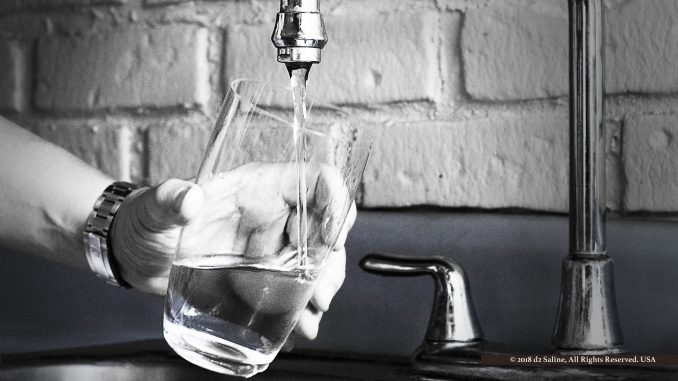
When a Saline water main broke last month it attracted major media coverage out of Detroit. Alternatively characterizing it as a “large” and “massive,” television station WXYZ Channel 7 deployed no less than a helicopter to provide live coverage. Who knew there was so much excitement to be had at the corner of North Maple and East Michigan Avenue? [1,2]
Grossly missing in so much of this was a substantive explanation of what had actually happened here. How likely is it to happen again? Are there choices that local government, or, in fact, the residents and businesses themselves can or should be making to swing the balance between a greater or lesser potential?
Have such choices already have been made?
To better understand the underlying issues here, Saline Journal sought out Tony Esposito. He actually teaches courses in technical supervision at Washtenaw Community College based on his own twenty-five years of experience in the pipefitting industry. He has earned journeyman cards in pipefitting, plumbing, and HVAC, and taught water distribution at the Piping Industry Training Center in Northwood, Ohio. [3,4]
Broadly speaking, he started by saying that municipalities consciously make the decision all of the time not to “wake a sleeping giant by digging them up.” And rightly so.
There are still a lot of water lines that are probably a hundred years old. They’re very common. We’re talking about going down five feet or more to get below frost and weather, to a depth of constant temperature. Every foot of replacement costs so much money. On top of the cost, people don’t want to be without water for long stretches while whole areas are replaced as a preventative measure.
When they are replaced, a key challenge is inevitably found at transition points between new installations and old. “How do you adapt to the older pipe installed or even repaired in the past at different periods of time? Some of that is wood.
That’s a problem you have to solve in the trench when you get there.
These are the sorts of situations that Jeff Fordice routinely faces as Director of Public Works (DPW) for the City of Saline. “Water main breaks are not unusual.
Over the past 25 years we have averaged more than seven breaks per year. Improvements to the distribution system have brought the ten- and five-year averages to under five breaks per year. In the past 25 years there has not been a year without a water main break. However, it is not uncommon for multiple breaks to occur along a main within a short time frame. For example, in 2006 there were six breaks along Old Creek Drive.
For budgeting and staffing of water main breaks we assume five per year.
New installation or repair, vibration and weight of traveling vehicles — and trucks in particular on Michigan Avenue — adds up. “It has to move over time,” Mr Esposito summarized. “You can try to keep it as still as possible, but the earth will do what it does.”
Today, odds are improved with the use of transits, computer-generated pitch models, and GPS positioning aids that weren’t practically accessible twenty to thirty years ago. Skilled tradesmen must complete five-year apprenticeships just to get their journeyman’s cards and supplement that with training every year in order to stay current with even newer tools as they become available.
“We maintain the equipment, supplies, and expertise to repair water mains in house,” Mr Fordice told Saline Journal.
Our crew needs to know how to operate excavation equipment, work around buried utilities, safely shore the excavation, and make the repairs …. Occasionally we have hired leak detection companies to help locate a leak that is not coming to ground in the vicinity of the leak.
On the recent break we brought in the Washtenaw County Road Commission to deenergize the pedestrian signal and DTE Energy to remove a street light.
Can this work involve dangers?
“There are all the usual hazards associated with excavations, such as bank collapse, in addition to the fact that we are often working around gas mains and electrical lines,” Jeff Fordice answered. “There are also risks associated with the water main. A live water main can have up to 70 PSI of pressure. That pressure can blow valves off or break joints if the repair is not adequately isolated.”
He went on to echo what had been shared separately by Mr Esposito: “There really aren’t preventative maintenance measures available for water mains.
The DPW is made up of a group of hard working, dedicated people, and we appreciate the support the community showed during this water emergency. What I think some people don’t understand is that there are only twelve crew members and how many different responsibilities that crew covers.
When over half the crew is working twenty hours on an emergency, there are a lot of other maintenance activities that will be put on hold and it will take a very long time to catch up.”
Now everyone has been given the opportunity to get a better understanding of that situation here.
True, it’s not the stuff of click-inducing headlines or rationalization for shooting video from the air. Rather, it’s the straightforward story of how the homes and businesses of Saline come to rely upon a clear flow of potable water on the vast majority of days when our Department of Public Works is not in the headlines.
References
- “Water main break in Saline causes city-wide loss of water pressure” Dave Bartkowiak Jr (May 16, 2018) Click on Detroit.
- “Water main break in Saline repaired, some businesses in area to remain under boil water advisory” Syma Chowdhry (May 16, 2018) WXYZ.
- Washtenaw Community College (home page).
- “Piping Industry Training Center” Toledo Construction.



